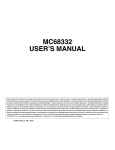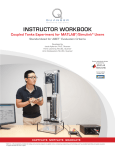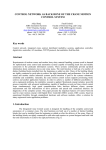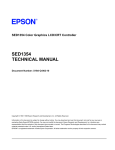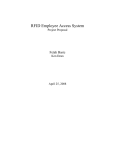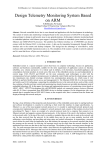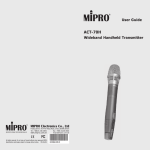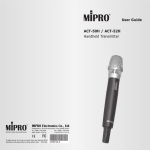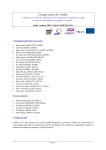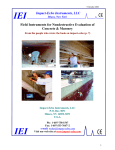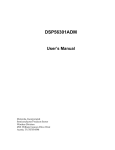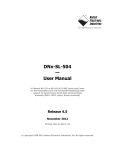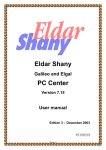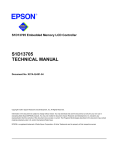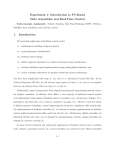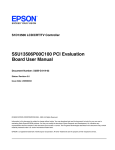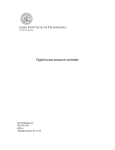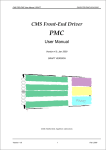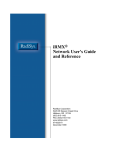Download voltage control system of self-excited brushless synchronous
Transcript
STEEL MILL CRANE MOTION CONTROL WITH A NEW INTEGRATED DRIVE CONTROLLER Alojz Slutej Lars Tuve Hansson Fetah Kolonić ABB Ind. Systems AB ABB Ind. Systems AB Faculty of El. Eng. and Comp. S-721 67 Västerås, Sweden S-721 67 Västerås, Sweden HR-10000 Zagreb, Croatia Summary: The steel and heavy industry in general demand increasingly powerful and flexible Distributed Control Systems (DCS). For cranes special attention should be given to the systems robustness, reliability and availability. The new Integrated Drive Controller (IDC) system as a part of DCS for steel mill crane application based on mentioned drive controller is shortly presented. 1. INTRODUCTION Integrated Drive Controller (IDC) is a specially designed speed control system for cranes and another heavy duty material handling systems. It is intended for slip-ring motors and fully supports positioning, brake control, rotor step switching and another application functions. The control system also includes protective functions that are necessary for crane motor drives application. Of the drive systems suitable for this size (201000kW) in this electrical and environmental situation the stator voltage controlled systems and slip-ring motors since long has been and still is the most suitable solution. The energy balance for a crane drive is normally not considered as important as the previous mentioned objectives. The installation cost and hence the suitability are however depending of the management of the losses on the crane. For the crane drive that most of its time is run in full speed up or full speed down the losses except motors and cables are about 4% of the motor power. The figure is similar to the described stator voltage controlled system for slip-ring motors and a regenerative frequency inverter drive system or a regenerative DC-drive system. The stator voltage controlled system has however the important advantage that the mayor part of the losses occurs in an external resistor, not inside the electrical equipment. The cost for high quality cooling systems on cranes in steel mills is high. The regeneration of the full speed lowering energy is based on direct connection by fully conducting phase control thyristors of the over synchronously running motor to the mains. The IDC with slip-ring motors is more robust for the momentary quality of the line voltage then another type of AC or DC drive. Of this reason it has been meaningful to design the new IDC for operation at a line voltage as low as 75% of the nominal voltage. 2. INTEGRATED DRIVE CONTROLLER Basically, the IDC performs Stator and Rotor control functions. Stator control is related to the torque control. Rotor control by optimizing the resistance gives the motor the right characteristics. The new drive minimizes the stator current and sensitivity to line voltage fluctuations considering the required torque. When lowering with a slightly higher speed then the motors synchronous, the motor will regenerate the energy back to the line in the most robust manner. Then the lowering speed is approaching the synchronous, the rotor resistor is minimized and the direction of torque changes electronically. 2.1. IDC configuration The drive system, both control system as well as power electronics, is made adaptable to meet all requirements of today's and future crane drives in steel production (Fig.1). The power electronics is made in a modular form which supports the integration into the cranes structure. The space requirement is low, and the temperature withstandability is high. The Control module is generating the firing pulses to the thyristors the MC68010, MC68020 and is binary and source code compatible with the Motorola MC68000family. The control board comprises a number of connectors interfacing other boards or devices. The MC68332 is a 32-bit integrated microcontroller with powerful peripheral Measurement: Line Voltage Stator Current Rotor Frequency Local Diagnostic: 2x 7'th segment Display Control: Firing pulse unit Bridge change log. TPU Back UP Power Supply: 24Vin, 5V,+/-15V Supervision: QSM MC68332 RWM fPROM QSP Data Bus Address Bus Control Bus Fig.1. Structure of integrated drive controller (IDC) module by means of a conventional wire, which limits the distance between these units to a few meters. All control system connections are made by optical fiber. The interfaces can be installed to optimize installation cost and reduce the interference. The commercially available standalone system consists of (Fig.2): • Thyristor Module Max 600 V Mains voltage, 25 - 2000 A • Control module - Thyristor module. (Cable max. length L=2m) • Control system module • Process I/O module (Control module and process I/O unit) • Cabin I/O module (Control module and cabin I/O unit)) Overriding control system Master -Follower drive control module Cabin I/O Module Line Control Module Operators Console #2 Thyristor Module 115 / 230 VAC Process I/O Module Motor Process information, Actuators Cabin I/O Module Operators Console #1 Fig. 2. Configuration of stand-alone version Optionally a rotor frequency evaluation unit is available, which replaces a hardware pulse transmitter on the motor. 2.2. Control system module design The control system module is built up around the Motorola MC68332 microcontroller unit, (Fig. 3). The CPU core of the microcontroller is based on Host Comm: DDCS Prot. Opto Link plastic 4MBaud Service Comm: DCB Prot. RS 232 9.6 KBaud P I/O Comm: FIELD Bus Prot. Opto Link Glass 2MBaud CMT Comm: DDCS Prot. Opto Link plastic 4MBaud Fig.3.Control system module block diagram subsystems [6]. MCU is based on the MC68020, the CPU instruction processing module utilize the extensive software based for the Motorola MC68k family. It includes an external interface and various functions that reduce the need for external glue logic (2 chip select lines, system protection, test, and clock submodule). The CPU module configuration registers allows the user to configure and monitor the system according to the system requirements. The system is set up by the local operating system software after a power on reset. Following monitoring functions are supported: • Halt Monitor, responds to an assertion on HALT_N on the internal bus. HALT_N is asserted if a double bus fault is generated. • Spurious Interrupt Monitor. If no interrupt arbitration occurs during an interrupt acknowledged cycle the BERR_N signal is asserted internally, and bus error exception is started. • Internal Bus Monitor takes care of the response time for all internal bus accesses. • Software watchdog, asserts reset if the software fails to service the software watchdog for a designated period of time. • Periodic Interrupt Timer, generates periodic interrupts. The timer is used for generating time scheduler interrupts, and the period time is set by the application software. • Reset Handling. The reset exception handling routines for the different types of reset are determined by programmer. The process I/O and Master/follower communication interface is a high speed data link based on the SDLC standard protocol [1]. The PC based Service Tool can communicate with any IDC connected to the bus. The PC is connected to the RS232 interface (9.6 kBit/s) of one IDC and communication to the other IDC's on the same bus is easily accomplished. The messages are relayed back and forth through that one IDC [4]. 2.3. Process I/O control module design The control module for different type of process I/O units is built up around the Motorola MC68302 microcontroller unit [7]. The CPU core of the microcontroller is based on the MC68000. The control module (Fig.4.) comprises a number of connectors interfacing other boards or devices: Control board, another process I/O modules and service terminal. the system according to the system requirements. The main Commmunication Processor (CP) is a RISC processor that services the three Serial Communication Channels (SCC). Serial Direct Memory Access channels are associated with three full-duplex SCCs. Each channel is permanently assigned to service the receive or transmit operation of one of the SCCs and is always available, regardless of the SCC protocol chosen. A watchdog timer is used to protect against system failures by providing a means to escape from unexpected input conditions, external events or programming errors. The system is set up by the local operating system software after a power on reset. 3. IDC SOFTWARE SUPPORT The IDC is on line programmable and various functions and operating modes can be selected by fixed number of parameters. The motor control programs are located in the control system module, which is controlled by either a torque or a speed reference provided locally ( stand-alone drive system ) or by the overriding system. Commissioning and Maintenance Tool (CMT) is ABB’s new PC based program for IDCs. The CMT offers the following functions: Fig.4. Process I/O module The MC68302 is a 32-bit Integrated microcontroller with powerful peripheral subsystems. MCU is based on the MC68000, the CPU instruction processing module utilize the extensive software based for the Motorola MC68K family. The device is especially suitable to applications in the communications industry for a wide variety of DCSs. The MC68302 contains an extensive support that simplifies the job of both the hardware and software designer. It integrates the MC68K core with the most common peripherals used in the well known MC68K base system. The independent direct memory access controller relieves the hardware design of the extra board logic. The interrupt controller can be used in a dedicated mode to generate interrupt acknowledge signals without external logic. The chip select signals and wait state logic are also totally integrated. The module configuration registers allows the user to configure and monitor • Monitoring of reference and actual values • Setting, changing, saving, uploading, downloading and restoring of parameters • Controlling and displaying data loggers The Process I/O basic software support and different communication drivers are located in the control module. 4. CONCLUSION The crane structure normally results in a certain distance range between the operator’s cabin and electrical room. The new Integrated Drive Controller (IDC) is suitable for this type of application, as it includes main control module and different type of remote I/O units. Besides the standard control features it includes following improvements: better and full control of the motor torque down to 70% of incoming line voltage, better heat endurance, static closed loop feedback for more accurate speed controller and much better man machine communication facilities. The drive controller has no need for manual adjustment to be able to compromise between the motors torque at lowest expected line voltage and lowest current at the nominal voltage. The new true feedback without movable parts fairly utilize a necessary information about rotor voltage frequency. The proposed method gives quite stable values around zero speed or unity slip, and reduces the need for mechanical tachometer or pulse encoders. To be able to find the right ramp times for acceleration and deceleration, the new system employs the torque as an internal variable. This means that ramps are set as torque instead time based functions. Important cranes, used in production, are not allowed to stop for single fault in the drive system. Of this reason the IDC is composed as individual system for each motion. Every particular sub-system can be linked in a superior overriding level for industrial automation and information interchange. 5. REFERENCES [1] Halsall, F. "Data Communications Commputer Networks and Open Systems", Addison-Wesley, 1992. [2] Fitzgerald, A.E, Kingsley C. Jr, Umans S.D. "Electric Machinery", McGraw Hill, 1991. [3] Say, M.G. "Alternating Current Machines", Longman Scientific & Technical, John Wiley & Sons Inc, 1983. [4] Slutej, A. "The new Multidrive concept for engineered drive application", invited paper, in Proceedings of Conference on Microcomputers in control systems, Mipro’94, vol.2, Croatia, 1994, pp1-5. [5] Åstrom, J.K, Wittenmark B. "Computer Controlled Systems", Prentice Hall International, Inc, 1984. [6] Motorola, "Embeded Control Family 68332", User’s manual 1995. [7] Motorola, "Integrated Multiprotocol Processor ", User’s manual 1991.




